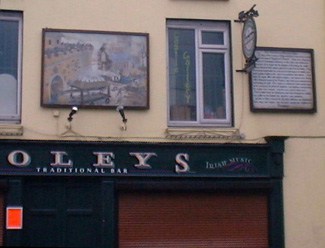
Sligo Castle was built in a commanding position on the corner of Teeling Street and Abbey Street, one of the main crossing points of old.
If you look up on the wall of Foley’s public house you will see a painting of what the old Sligo Castle may have looked like along with a brief history.
Sligo Castle was built here in 1245 and a Dominican Friary was founded in 1295. In 1310 a new castle was built and a new town laid out by Richard III de Burgo, the Red Earl of Ulster.
This castle was destroyed in 1315 by the O’Donnells. The O’Connor’s in Sligo then had effective control of the town throughout the 14th century. In the 15th and 16th centuries the town’s prosperity owed much to the proximity of the herring shoals.
The later war’s of the 16th century, principally between the O’Neills and the O’Donnells against Queen Elizabeth I, devastated the town. However, after 1603 and the end of the war’s the settlement began to prosper once again.
In 1641 the town and Friary were sacked by the Parliamentarian, Sir Frederick Hamilton. In 1645 the town was captured by the Cromwellian – Sir Charles Coote II. In 1689 it was seized by Williamite rebels under Lord Kingston, but was retaken by Patrick Sarsfield for King James.
Continue towards our next point of interest by turning right and then walking along Castle Street, the same direction as the traffic, for 100 metres or so, until you reach a statue in the middle of the road, this is The Lady Erin Monument.
Comments are closed.